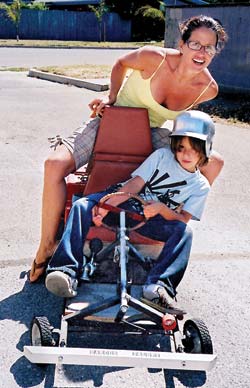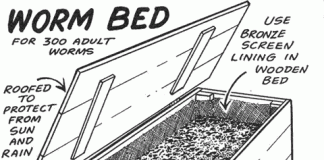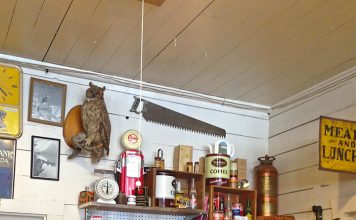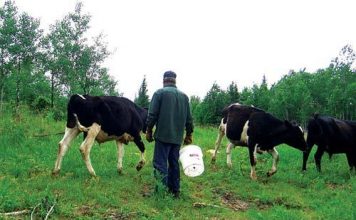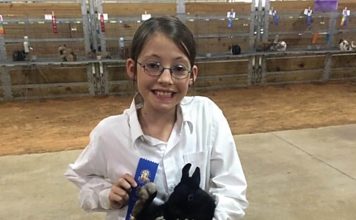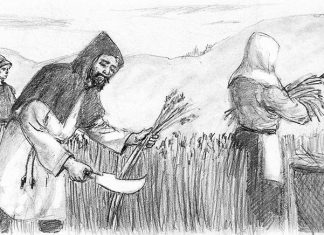 |
|
| Website Exclusive • May, 2010 |
Grandma Clara used to delight in telling us the story of our Dad’s first complete sentence at age 2 when he received a toy car for Christmas: “It’s got GEARS!” I guess it was the WAY he said it with the long drawn-out emphasis on GEEEEERS that made it so memorable—and laughable.
|
Little did they know at the time, but his enthusiastic burst of joy over those little wooden cogs, revealed his interest and passion in all things mechanical that would manifest itself in creative projects and inventions throughout his life (1914-1994).
He ended up with six kids and worked as an auto mechanic to feed his hungry hoard, but that didn’t put a damper on his creative side. When he was home he was forever building boats, painting beautiful oil landscapes, and making sure all six of us were happily MOBILE. Being a mechanical genius of sorts, he prided himself on never having to spend any money to keep us on wheels. (As the sole breadwinner for 8, he didn’t HAVE any money.)
We enjoyed a “poorman’s fleet”: doodlebugs (motor-scooters) for the older kids, and go-karts for the younger ones. He built them out of lawnmower engines and drive-chains and GEEEERS. At age 7, I remember riding my gas-powered doodlebug over to Lota Jean’s house to play and she would try to keep up with me on her fancy bicycle. Mom called her “the poor little rich girl” because she had EVERYTHING—but a doodlebug. I had NOTHING—but a doodle bug—and a really cool family.
We all grew up and graduated to cars and motorcycles and had kids of our own, but some of us carried on the family tradition of scrounging for parts and building something from nothing. Even if whatever-it-was ended up looking like a contraption, at least it worked and we had fun with it.
My older brother Gene: professional deep sea diver, astronomer (telescope maker), builder, artist, writer, poet, musician, and tinkerer/inventor—-added “grandfather” to the list a few years ago.

When I visited my daughter Cynthia and 7-yr.old grandson Zane in Hollywood last summer, we went to visit ‘Uncle Gene’ just to ride the go-kart. It was great fun and well worth the 100-mile drive. The “jalopy” runs on a lawn mower engine, but can be switched over to run quietly on the battery if a younger child is intimidated by the sound of the gas engine. Zane tried both and found the gas-powered mode to be as fast as he wanted to go.
Gene said he’d be happy to share the sketched plans and how-to info with Backwoods Home Magazine readers, so in this article, with his help, I’ll do my best to basically illustrate how to build this thing. The specs and photos will have to tell the story.
Please note that you will need some degree of mechanical understanding and ability, and some experience and skill in using tools, to construct it. This article is simply the documentation and illustration of a prototype that Gene fashioned out of new and used parts as he went along, and it only cost $150.
Feel free to alter the dimensions and make any other changes you want to customize it to fit your needs. If you have money to burn you can make this go-kart as fancy as you desire. Build a body, a sheet metal cowling, fenders, add paint and pin-striping, or anything you else you might dream up.

BASIC CONSTRUCTION SPECS:
CHASSIS: 1-inch box steel tubing for main chassis and 2-inch channel iron for rear cross member. 5/8″ plywood for floorboards. All steel members are welded (best way) but could be bolted together if welder not available.
ENGINE: 2HP Briggs and Stratton gas engine with centrifugal clutch (lawnmower engine). NOT a rotary engine, but the self-propelled type of lawnmower engine. Get any size HP engine you want. Gene wanted a small engine without too much power–for a young child. Common sizes are 3 to 5 HP. You can find 2HP engines only in the older model lawnmowers. It runs top speed at 3600 RPM, but with the 4 to 1 pulley ratio, it runs at 3000 RPM and delivers about 1.5 HP. Note: The pulleys determine the “gearing”: how fast it takes off and how fast it goes. A 5 to 1 pulley ratio would have a faster top speed.
ELECTRIC DRIVE: Delco-Remy 30-amp 12-volt DC generator which acts as a 12 volt DC motor when armature and fields are excited by battery-supplied 12-volt current (hence “generator/motor”). The generator/motor is limited by the 12V battery output so it produces only about 1/2HP, just enough to give a small child a thrill. Use a 12 volt DC battery from an electric-start riding lawn mower, or large motorcycle battery, or regular car battery if you can make room for it.
You might wonder what the difference is between an electric motor and an electric generator? The answer is technically no difference. If you connect a 13-volt generator to a 12-volt car battery, it’ll run just like a motor with a slow turning shaft. Apply mechanical power ( hook it up to the gas motor via pulleys and belt off the shafts) and it works as a generator that recharges the battery because the shaft is now turning fast. The catch is you have to put a voltage regulator between the battery and the generator. It has 2 relays inside it. One relay keeps the generator from over-charging the battery when the shaft is turning fast and the other relay disconnects the battery from the generator when the shaft is turning slowly and starts to drain the battery, hence the name “regulator”. This “hybrid” go-kart works in either mode by flipping a switch.
WHEELS: Fronts are 7″ dia. ball-bearing type on independent steering axles. Rears are 10″ dia. on 3/4″ iron pipe. Both sets have hard-rubber tires, but air tires can be used and offer a smoother ride if you have a bumpy road.
DIMENSIONS: Approximately 2 feet wide and 4 feet long, but you can make it any size that will accommodate all the parts and accessories to work in unison in a practical compatible design.

ACCESSORIES:
A. On/off toggle switch for electric motor drive.
B. Voltage regulator for charging battery when in gas engine mode.
C. Voltmeter and ammeters for monitoring battery voltage and charging rate. When I asked Gene why it has a voltmeter AND an ammeter, he said the voltmeter shows battery voltage during charge and discharge mode; the ammeter shows rate of discharge during electric motor mode, and rate of charge during gas engine mode. Be sure to get a “center-off” ammeter.
D. Chain drive with 4 to 1 sprocket ratio and centrifugal clutch for the gas engine.
E. Electric V-belt drive with 4 to 1 ratio on pulleys for the electric motor/generator and for battery charging.
F. Brake (hand brake) is V-belt drag-type (sheave) on rear axle activated by cable and pull-bar. A sheave is a pulley with a V-belt loosely around it, with the opposite side fastened to the frame and rear axle. When you pull on a lever or press on a foot pedal it puts friction on the sheave and acts as a brake.
G. Tie-rod type direct ratio steering on front independent axles. Front axles are 1/2″ steel rod.
H. Spring-loaded aluminum bumpers front and rear made from 2″ angle stock.
I. 12-Volt DC headlight and switch.
J. Seatbelt, roll-bar, and stepped-up seat on back for adult passenger.
K. Squeeze bulb air horn, or electric horn with a horn button (easy to wire to the battery) and they are plentiful at wrecking yards. (Funsies!)
|
CONSTRUCTION SEQUENCE:
Assemble and weld up chassis frame.
Mount axles and wheels and steering linkage to shaft and steering wheel.
Mount large pulley and sprocket and brake drag pulley on rear axle pipe.
Install gas engine and motor/generator with small pulley and sprocket to line up with counterparts on rear axle.
Mount voltage regulator gauges and switches and wire up to battery (#10 wire), and install headlight & horn with #16 wire. (Headlight and horn optional but look “cool” to the kids)
Weld up seat frame and roll bar and mount seats.
Install plywood floorboards.
Install bumpers.
Ride Sally Ride!
SUGGESTED SOURCES FOR MATERIALS:
Engine: Lawnmower repair shop, or want-ads for cheap used lawnmowers, or recycling yards at the dump. The best bargain would be a discarded riding mower that had not only an engine but the front axle and steering mechanism still intact (ideal).
Generator/motor: Auto parts store or generator/alternator repair shop, wrecking yard ,or recycling yard at the dump.
Battery: WalMart or lawnmower shop or automotive dept. in big variety store, wrecking yards. If you can’t find a GOOD used one , buy a new one with a long life you can depend on.
Wheels: Ace Hardware or from lawnmowers in recycling yards. You can use air tires (tube tires) for a softer ride instead of hard rubber tires. Look for either.
Belts and pulleys: Ace Hardware or automotive shops like Napa Auto Parts.
Chain sprockets and chain: Lawnmower shop or recycling yards.
Box tubing and channel iron: Welding supply , but better yet and cheaper at scrap-iron yards or iron and steel works. (See Yellow Pages) Ace hardware, Home Depot, and Lowe’s has assorted angle iron and aluminum.
Plywood: Lumber yard, and other building supply places like Home Depot and Lowe’s (open weekends).
Wire: Napa Auto Parts, Lowe’s, Home Depot, Hardware stores. Use #10 copper stranded wire where indicated on wiring diagram (inc. ground wires) and #16 copper stranded everywhere else. (Stranded is easier to work with than solid)
Scrounge materials anywhere you can think of and with a little luck and ingenuity the go-kart shouldn’t cost over $150. Be innovative and see photos for reference.
Buckle up and wear a helmet.
Good Luck and Happy Motoring!
Questions? Email Dave at editor@backwoodshome.com to forward your questions to Gene via Dorothy and she will get back to you.
|
Learn more about Dorothy and/or contact her at her website www.dorothyainsworth.com


